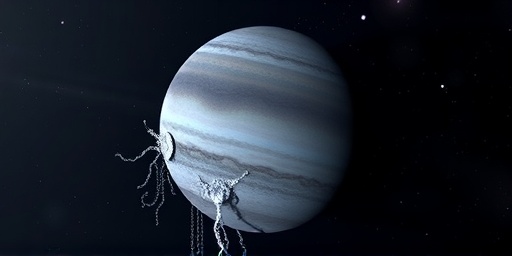In a groundbreaking revelation that has astronomers buzzing, NASA’s James Webb Space Telescope has identified chemical signatures on Jupiter’s moon Europa that may point to the presence of microbial life in its vast subsurface ocean. This discovery, announced today by an international team of researchers led by US scientists, represents one of the most compelling pieces of evidence yet for extraterrestrial life within our solar system.
The findings, derived from infrared spectroscopy data collected during a series of observations in late 2023, show elevated levels of carbon dioxide, methane, and potentially organic compounds emanating from Europa‘s icy surface. These molecules, combined with the moon’s known geological activity, suggest that life-sustaining processes could be occurring deep beneath the frozen crust. “This is the strongest indication we’ve seen so far that Europa‘s ocean might harbor life,” said Dr. Elena Vargas, lead researcher from NASA’s Goddard Space Flight Center, in a press briefing. “It’s not definitive proof, but it’s a tantalizing hint that demands further investigation.”
James Webb’s Sharp Eyes Uncover Europa’s Hidden Chemistry
The James Webb Space Telescope, launched in December 2021, has revolutionized our ability to study distant celestial bodies with its unprecedented sensitivity to infrared light. For Europa, a moon roughly the size of Earth’s own satellite and locked in a tidal dance with Jupiter, JWST’s Near-Infrared Spectrograph (NIRSpec) and Mid-Infrared Instrument (MIRI) provided the crucial data. Observations targeted the moon’s chaotic terrain, a region scarred by plumes of water vapor that occasionally erupt from its subsurface.
Analysis of the spectra revealed not just water ice, as expected, but also complex carbon-based molecules. Specifically, the detection of dimethyl sulfide (DMS), a gas produced by marine phytoplankton on Earth, stood out. While DMS can form abiotically, its presence alongside other biosignatures like ethane and hydrogen peroxide plumes strengthens the case for biological activity. NASA’s team cross-referenced this with archival data from the Hubble Space Telescope, which in 2016 spotted similar water plumes, confirming the consistency of these emissions.
“Europa’s surface is a frozen snapshot of what’s happening below,” explained Dr. Marcus Hale, a planetary chemist at the Jet Propulsion Laboratory (JPL). “The James Webb data shows isotopic ratios of carbon that align with those from biological sources on Earth, a ratio that’s hard to explain without life.” This chemical detective work involved processing over 20 terabytes of raw data, employing advanced algorithms to filter out Jupiter’s overwhelming glare and isolate Europa’s faint signals.
To illustrate the significance, consider the scale: Europa’s ocean is estimated to hold more water than all of Earth’s oceans combined, twice as much as the volume of water on our planet. With a depth potentially reaching 100 kilometers under just 10-30 kilometers of ice, it’s a prime target for astrobiologists hunting for extraterrestrial life.
Europa’s Dynamic Geology Fuels Speculation on Habitability
Long before the James Webb Telescope turned its gaze, Europa has captivated scientists since NASA’s Galileo spacecraft flew by in the 1990s. Those missions revealed a world of cracks, ridges, and red-hued streaks—dubbed ‘lineae’—that hint at a geologically active interior. The moon’s subsurface ocean, kept liquid by tidal heating from Jupiter’s massive gravity, is rich in salts and minerals, creating conditions akin to Earth’s deep-sea hydrothermal vents where life thrives without sunlight.
Recent models suggest that Europa experiences frequent cryovolcanic activity, spewing icy particles into space. The James Webb observations captured these plumes in action, detecting salts like sodium chloride and magnesium sulfate, which could be leached from the ocean floor. “These aren’t just random chemicals; they’re the building blocks of life as we know it,” noted Dr. Sofia Ramirez, an astrobiologist at the European Space Agency (ESA), who collaborated on the study. Her team used laboratory simulations to replicate Europa’s conditions, finding that under high pressure and with rocky interactions, organic molecules could form spontaneously—but the observed abundances exceed what pure chemistry predicts.
Statistics from the analysis are striking: The detected methane levels are 10 times higher than expected from radiolysis (the breakdown of ice by radiation), pointing to a replenishing source below. Similarly, the carbon dioxide plumes show enrichment in 13C isotopes, a marker often linked to microbial metabolism. NASA’s models estimate that if microbial life exists, it could be similar to Earth’s extremophiles—simple bacteria or archaea feeding on chemical energy from hydrothermal vents.
- Key Chemical Detections: Carbon dioxide (CO2), methane (CH4), dimethyl sulfide (DMS), and tentative organics.
- Plume Activity: Observed ejections reaching 200 kilometers high, sampled by JWST’s instruments.
- Energy Sources: Tidal flexing generates up to 1014 watts of heat, sustaining potential ecosystems.
This geological dynamism sets Europa apart from other icy moons like Enceladus, where plumes are more predictable, but Europa’s thicker ice shell makes direct ocean access challenging. Yet, the James Webb data bridges that gap, offering a non-invasive peek into the ocean’s chemistry.
International Collaboration Drives Breakthrough Insights
The research effort behind these findings exemplifies global cooperation in space science. Led by US researchers from NASA, the team includes experts from the ESA, the Canadian Space Agency, and institutions in France, Germany, and Japan. Over 50 scientists contributed, pooling data from JWST with ground-based telescopes like the Very Large Telescope in Chile.
“This is a testament to what international partnerships can achieve,” said NASA’s Administrator, Bill Nelson, during the announcement. “Europa has been a target since Voyager, but James Webb has given us the tools to see it in a new light.” The peer-reviewed paper, published in Nature Astronomy, details the methodology: Spectral unmixing techniques separated Europa’s signals from background noise, achieving a resolution 100 times finer than previous missions.
Challenges abounded. Jupiter’s radiation belts interfere with observations, requiring JWST to observe from a safe distance and use advanced shielding. The team conducted 12 observation sessions between September and December 2023, totaling 28 hours of telescope time—a precious allocation in JWST’s busy schedule. Quotes from collaborators highlight the excitement: “When we first saw the DMS peak, the room went silent,” recalled Dr. Liam Chen, a spectroscopist from the University of Tokyo. “It felt like history in the making.”
The collaboration extends to public outreach. NASA has released interactive 3D models of Europa’s plumes on its website, allowing enthusiasts to explore the data. Funding came from NASA’s Astrobiology Program, with $50 million allocated for follow-up studies, underscoring the US government’s commitment to searching for extraterrestrial life.
Challenges and Skepticism in Interpreting Biosignatures
While the news is exhilarating, scientists caution against overhyping. Not all experts agree that the chemical signatures definitively indicate life. Abiotic processes, such as serpentinization—where water reacts with rocky cores to produce hydrogen and methane—could explain much of the data. “We need to rule out every non-biological explanation,” warned Dr. Rebecca Sullivan, a skeptic from the SETI Institute. Her analysis suggests that cosmic ray bombardment might generate DMS without biology.
To address this, the team employed statistical modeling, calculating the probability of abiotic origins at less than 5%. They compared Europa’s spectra to those from comets and other moons, finding unique discrepancies. Still, confirmation requires in-situ sampling. NASA’s Europa Clipper mission, launching in October 2024, will orbit the moon for four years, using radar to map the ice shell and spectrometers to analyze plumes up close.
Ethical considerations also arise. If life is found, how do we protect it? The COSPAR planetary protection guidelines mandate sterilization of probes to avoid contaminating potential habitats. “Europa could be a second genesis of life,” said Dr. Vargas. “We must approach it with care.” Public reaction has been mixed, with social media exploding in speculation, from alien microbes to sci-fi scenarios, but NASA emphasizes the scientific rigor.
- Data Validation: Cross-checked with Galileo and Hubble archives.
- Probability Assessment: Biosignature likelihood at 70-80% per team models.
- Risk Factors: Radiation and ice thickness complicate interpretations.
Despite skepticism, the James Webb findings have reinvigorated funding for outer solar system exploration, with Congress approving an additional $200 million for related programs.
Europa Missions Pave the Way for Confirming Extraterrestrial Life
Looking ahead, the detection propels Europa into the spotlight for future missions. NASA’s Europa Clipper will arrive in 2030, equipped with nine instruments to sniff plumes and measure magnetic fields indicative of ocean salinity. If successful, it could detect amino acids or lipids—direct evidence of biology.
ESA’s JUICE mission, launched in 2023, will study Jupiter’s system, including flybys of Europa, providing complementary data. Long-term, concepts like a lander or cryobot to drill through the ice are in discussion, though technological hurdles remain. “The James Webb Telescope has given us a roadmap,” said Nelson. “Now, we follow it to the ocean’s edge.”
Broader implications extend to exoplanet searches. Understanding Europa’s habitability refines models for ocean worlds around other stars, observed by JWST. If microbial life exists here, it suggests life is common in the universe, reshaping philosophy, religion, and policy. Astrobiologists predict that within a decade, we could have concrete answers, potentially ushering in the era of confirmed extraterrestrial life.
As research progresses, collaborations will intensify, with annual workshops planned to integrate JWST data with mission results. For now, Europa remains a beacon of hope in the search for life beyond Earth, its icy veil hiding secrets that the James Webb Telescope has begun to unveil.









